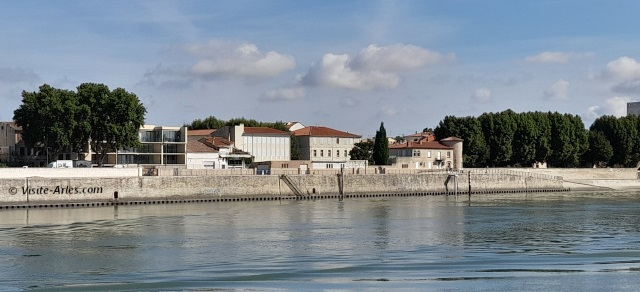Visit Arles, the roman city

Arles is a historic town located in the Provence region of southern France. Its history dates back to ancient times, with evidence of human settlement in the area as far back as the Bronze Age. The city's strategic location along the Rhône River made it an important trading and cultural center throughout its history. One of the most significant periods in Arles' history was during the Roman era. It became a Roman colony in 46 BC and quickly developed into an important regional capital. The city was known as "Arelate" during this time and served as a major hub for trade, as well as an administrative center for the surrounding region. Arles was renowned for its impressive Roman architecture, including the Arena of Arles (Amphitheatre), which is still standing today and is one of the best-preserved Roman amphitheatres in the world. The Roman theatre, cryptoporticus, and other structures also highlight Arles' importance during this period. In the early Middle Ages, Arles continued to thrive as a cultural and trading center. It became a prominent religious center as well, with the construction of the Church of St. Trophime, a stunning example of Romanesque architecture. The city's role as an important center declined somewhat in the later Middle Ages, but it remained a significant regional town.
Arles in the 19th century
During the 19th century, Arles gained attention from artists, most notably Vincent van Gogh, who lived and painted in the area. His famous work "Starry Night Over the Rhône" was inspired by the beauty of the city and its surroundings. The city's artistic heritage has continued to flourish, and Arles is known for hosting the Rencontres d'Arles, an annual photography festival. Arles also played a role in the development of photography itself. In 1839, Louis Daguerre unveiled his daguerreotype process in the city, marking a pivotal moment in the history of photography. Today, Arles is a UNESCO World Heritage site, celebrated for its rich history, Roman architecture, and vibrant cultural scene. The city's legacy as an important center of art, trade, and culture continues to attract visitors from around the world.
Julius Caesar in Arelate

Photo of the presumed bust of Julius Caesar at the MDAA in Arles.
Julius Caesar, the renowned Roman general and statesman, played a significant role in the history of Arles during the Roman era. In 49 BC, as part of the civil war between Caesar and Pompey, Arles became a crucial site for Caesar's military and political activities. During this time, Caesar chose Arles as a base of operations for his campaigns in Gaul (modern-day France). He recognized the strategic importance of the city's location on the Rhône River, which allowed him to maintain control over important trade routes and communication lines. Arles provided a vital link between the Roman territories in Italy and the newly conquered regions in Gaul. Caesar's presence in Arles led to the construction of significant infrastructure, including bridges and roads, to facilitate the movement of troops and supplies. He also initiated the building of a new harbor, known as the Portus Julius, which aimed to enhance the city's maritime capabilities and strengthen its position as a regional center. The city's importance during this period is attested by historical records and archaeological findings. Arles served as a key military and administrative center for Caesar's operations, and its status as a Roman colony was solidified. Caesar's time in Arles was marked by both military and political activities, as he continued to consolidate his power and expand Roman influence in the region. His presence contributed to the city's growth and development, leaving a lasting impact on its history. It's worth noting that while Caesar's time in Arles was significant, his overall role in Roman history extended far beyond his stay in the city. His military campaigns, political reforms, and eventual assassination all played crucial roles in shaping the Roman Republic and the transition to the Roman Empire.
Arles today
Arles is a vibrant and historically rich city in modern times. It has managed to retain much of its historical character while also embracing contemporary culture and developments. The city is renowned for its well-preserved Roman and Romanesque architecture, which continues to be a major attraction for visitors. The Arena of Arles (Amphitheatre) still stands as a remarkable testament to the city's Roman heritage and hosts various events, including bullfights and concerts. The Roman Theatre and the Alyscamps necropolis are other examples of Arles' ancient heritage that can still be explored. Arles has also become a hub for arts and culture. It gained further artistic significance due to Vincent van Gogh's association with the city, and his influence can be felt throughout the area. The city hosts the Rencontres d'Arles, an internationally renowned photography festival that attracts artists and enthusiasts from around the world. This event showcases contemporary photography and contributes to the city's reputation as a cultural center. Modern Arles features a charming old town with narrow streets, bustling markets, and inviting cafés. The Place de la République is a central square that serves as a gathering point for locals and visitors alike. The Church of St. Trophime, a prime example of Romanesque architecture, remains an architectural gem in the heart of the city. Arles is also known for its natural beauty and proximity to the Rhône River. The surrounding Camargue region is famous for its unique landscapes, marshes, and diverse wildlife, including the iconic Camargue horses and pink flamingos. In recent years, efforts have been made to enhance Arles' appeal as a cultural destination and promote sustainable tourism. The city's blend of historical significance and contemporary artistic expression makes it a captivating place to explore, where the past seamlessly intertwines with the present. Arles today is a harmonious fusion of ancient heritage, artistic vitality, and a picturesque Provençal ambiance that continues to captivate visitors and residents alike.
